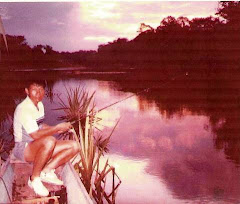AN ANSWER TO SOLVE SARAWAK'S POWER SUPPLY WOES IN THE RURAL AREAS.
Development in Sarawak is seen and felt to be painfully slow. There seemed to be not much changes since it became independence within Malaysia 46 years ago. Before Independence, we were unhappy about 4 things - our roads, electricity, water and livelihood/economy. Today, we are still clamouring for the same thing plus an additional problem in the form of Native Customary-Right land (NCR)
Roads. The Kuching-Sri Aman trunk road was built in 1960. At about the same time a side road from my kampung (Lachau) to the many long houses deeper inland was also constructed. It made a big circle inland to connect the many long houses inside and came out to rejoin the main trunk road a few kilometres further up from the Lachau Bazaar. Whilst the upper half of this road had been sealed more than a decade ago, the lower half remained as it has always been. Although it was purportedly under the maintenance of CMS Sdn Bhd, proper and scheduled maintenance is apparently lacking judging by the uneven and rocky/stony condition which is hardly fit for vehicles.
Electricity and water supply. It is the dream of every household to have a proper TNB/SESCO- supplied power. We thought, the construction of the Batang Ai Hydroelectric Power Dam would solved this problems for the folks in the Second Division. We were wrong. That project is not for us. Today, we are left gaping at the sights of the pylons and high tension cables bypassing us overhead, bringing the power supply to Kuching. There is some comfort, though, as the long houses are given a generator. Soon, however, it became a burden. They have to buy diesel to keep it going. Even running it for only two hours each night, would incur our long house a diesel bill of RM400.00 a month. For a family who don't have even a small rubber plot and a fix income, the amount they would have to chip in to buy the diesel, though small, is big amount to them.
 Turbine (red drum) and Dynamo (blue)
Turbine (red drum) and Dynamo (blue)
 One end of the turbine, powered by water from a nearby waterfall.
The water is channelled by pvc pipes into the turbine.
One end of the turbine, powered by water from a nearby waterfall.
The water is channelled by pvc pipes into the turbine.
 The powerful water that turn the turbine spill down to the ground.
The powerful water that turn the turbine spill down to the ground.
 The water can be stopped by a vavle (the red lever)
The water can be stopped by a vavle (the red lever)
 Wilfred Sedau showing the vavle.
Wilfred Sedau showing the vavle.
 This is the picture of a modified Mini Hydroelectric power generator used by a Penan in his home. It is powered by a 3kilowatt dynamo which is enough for a home. Total cost is in between RM3,000 to RM5,000.
This is the picture of a modified Mini Hydroelectric power generator used by a Penan in his home. It is powered by a 3kilowatt dynamo which is enough for a home. Total cost is in between RM3,000 to RM5,000.




Sir..
ReplyDeleteThanks for the article in English.
We should create and enlarge this technology.
Best regard;
Penemuruai